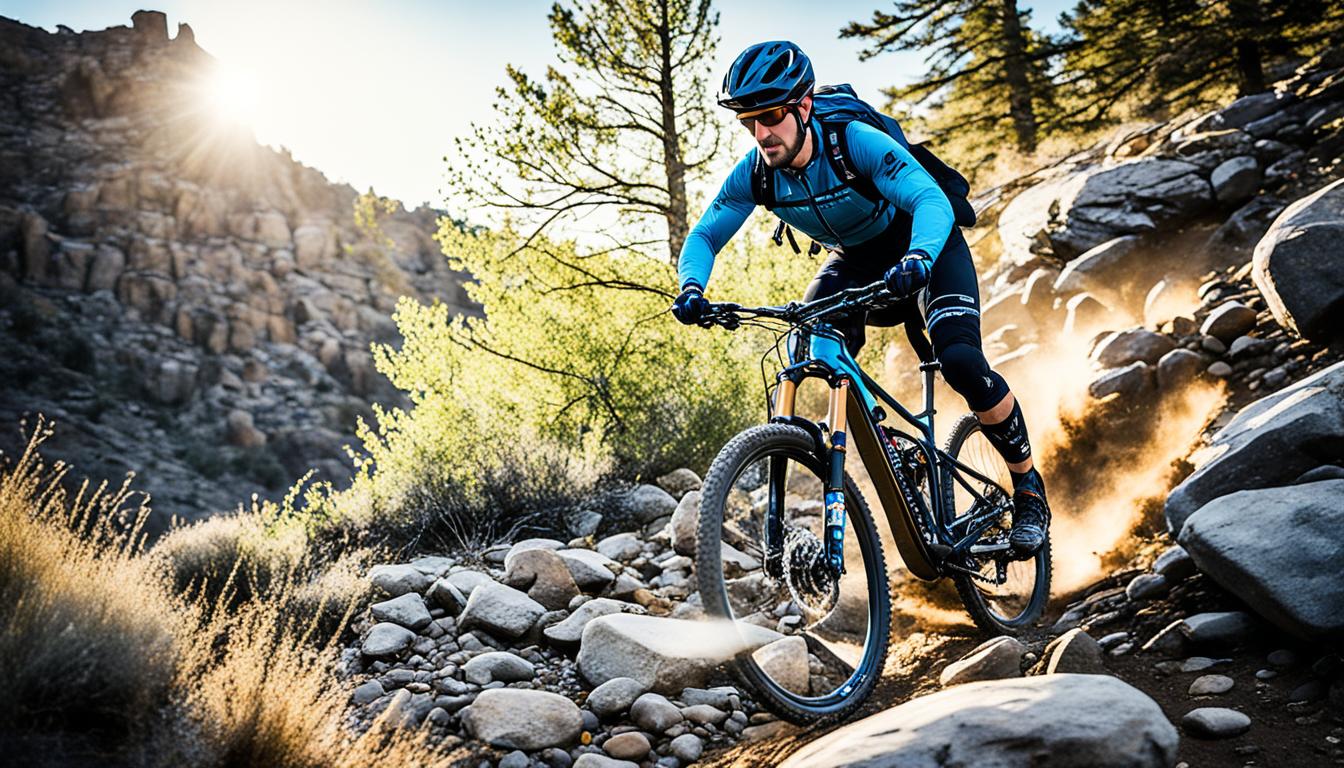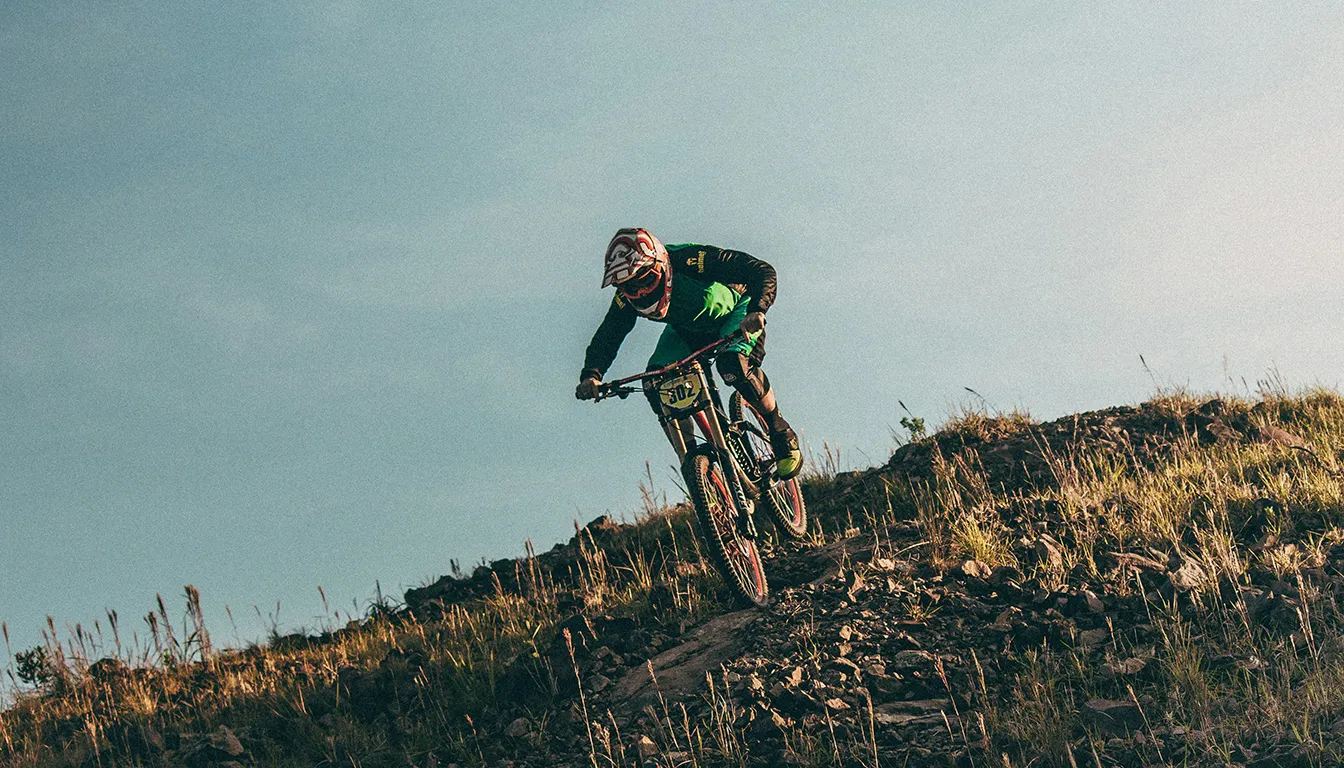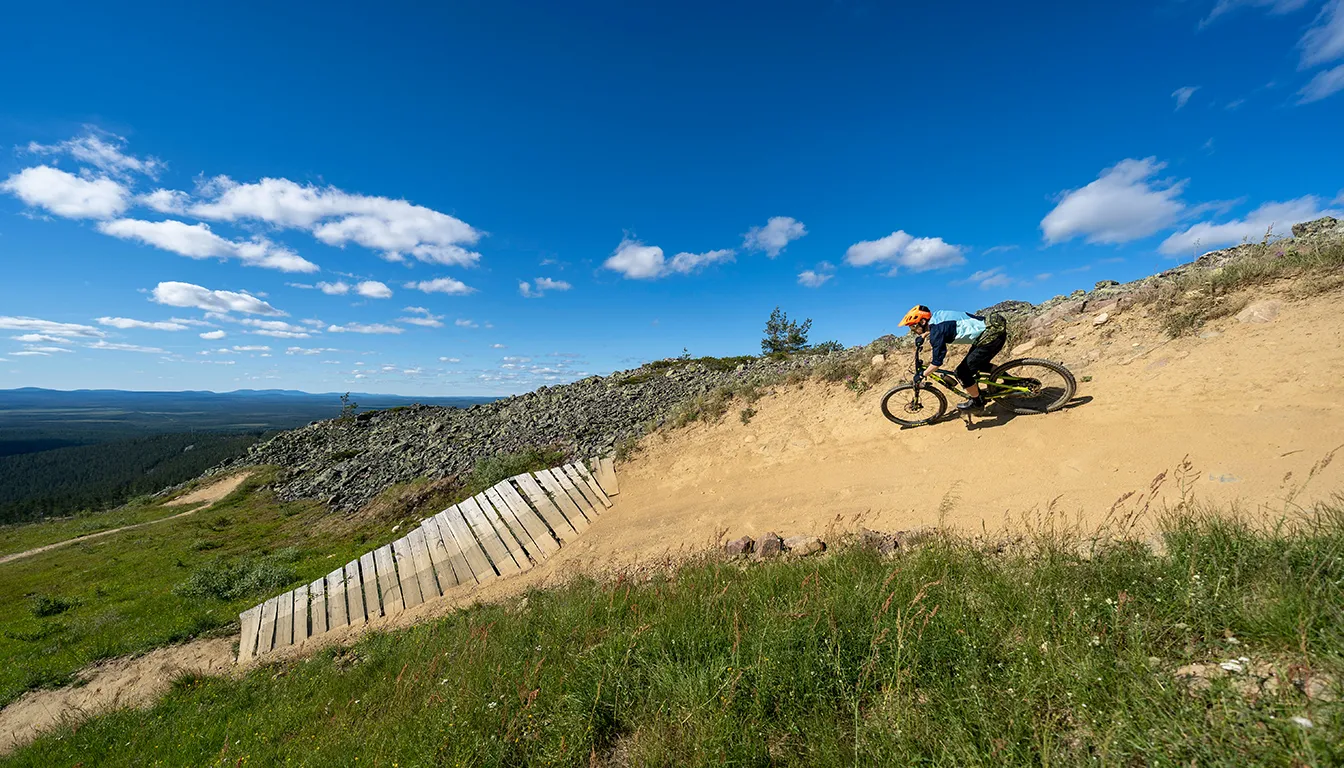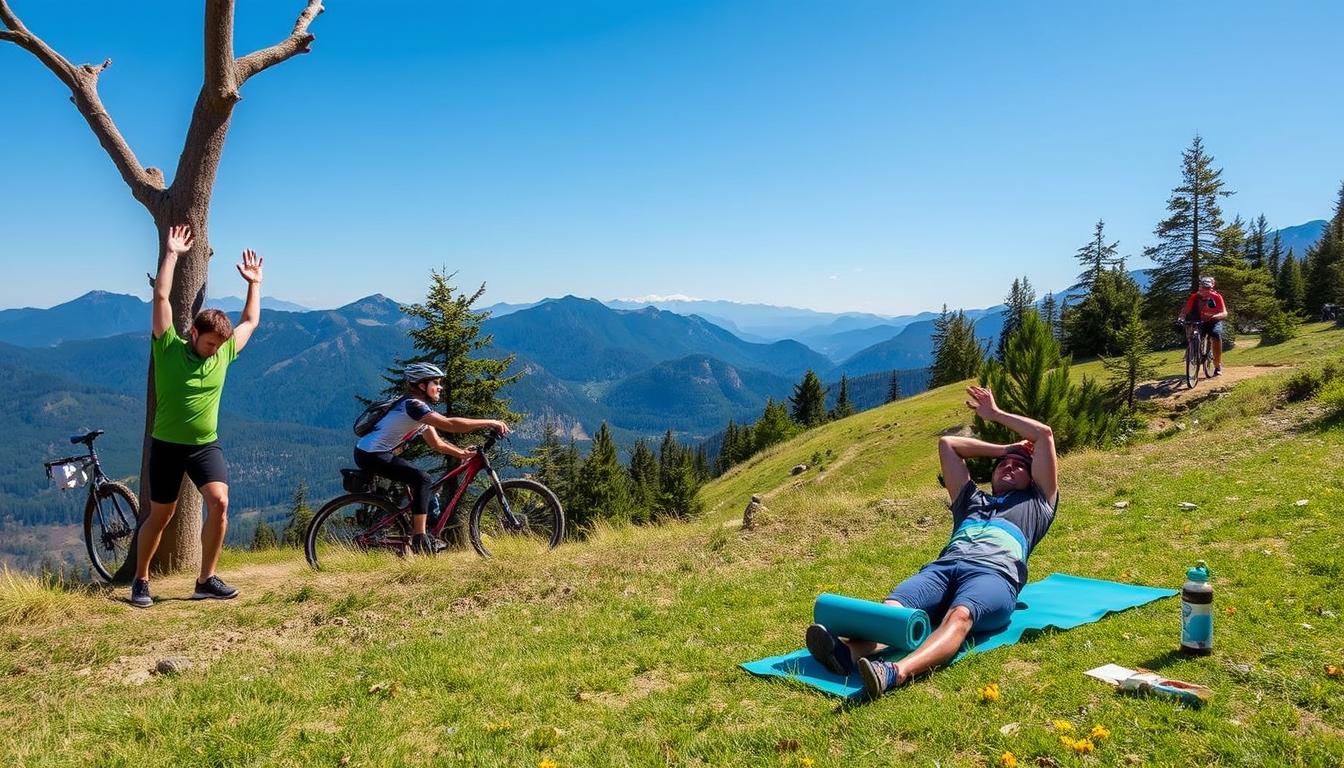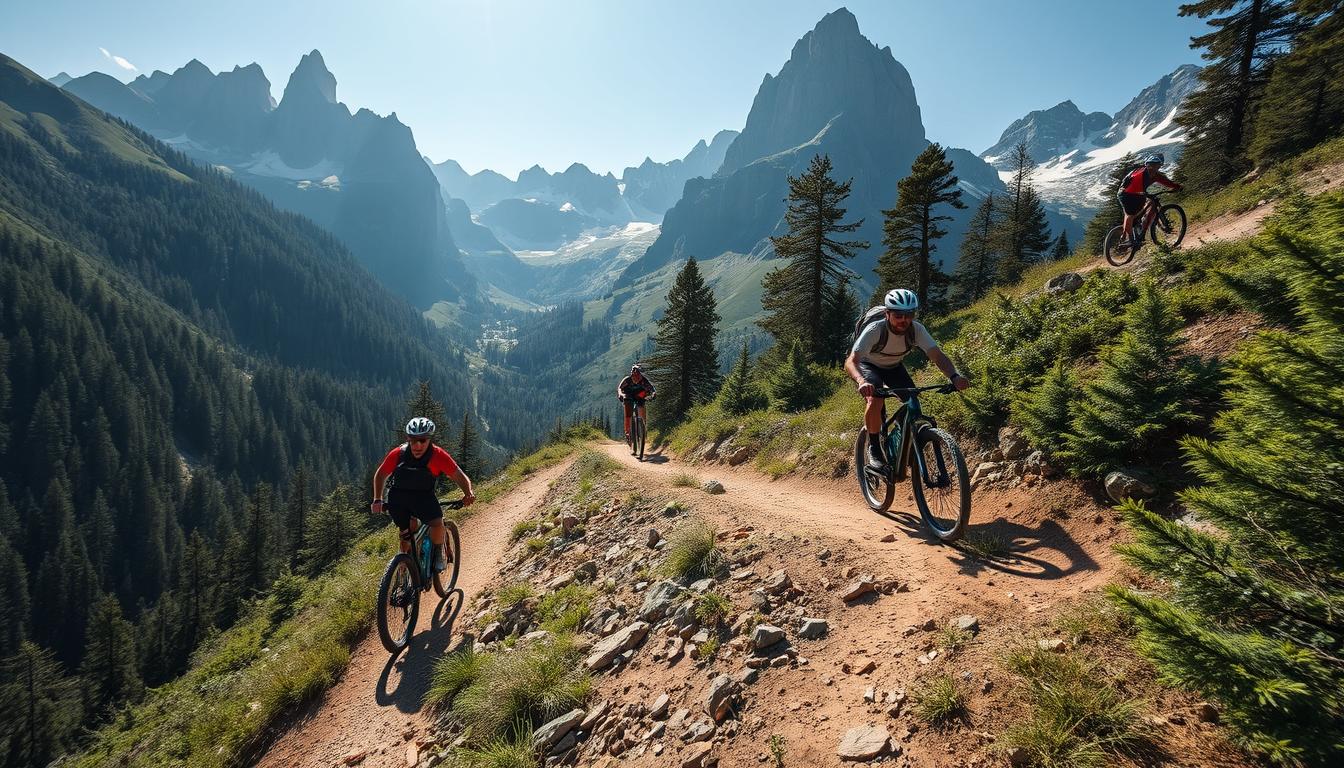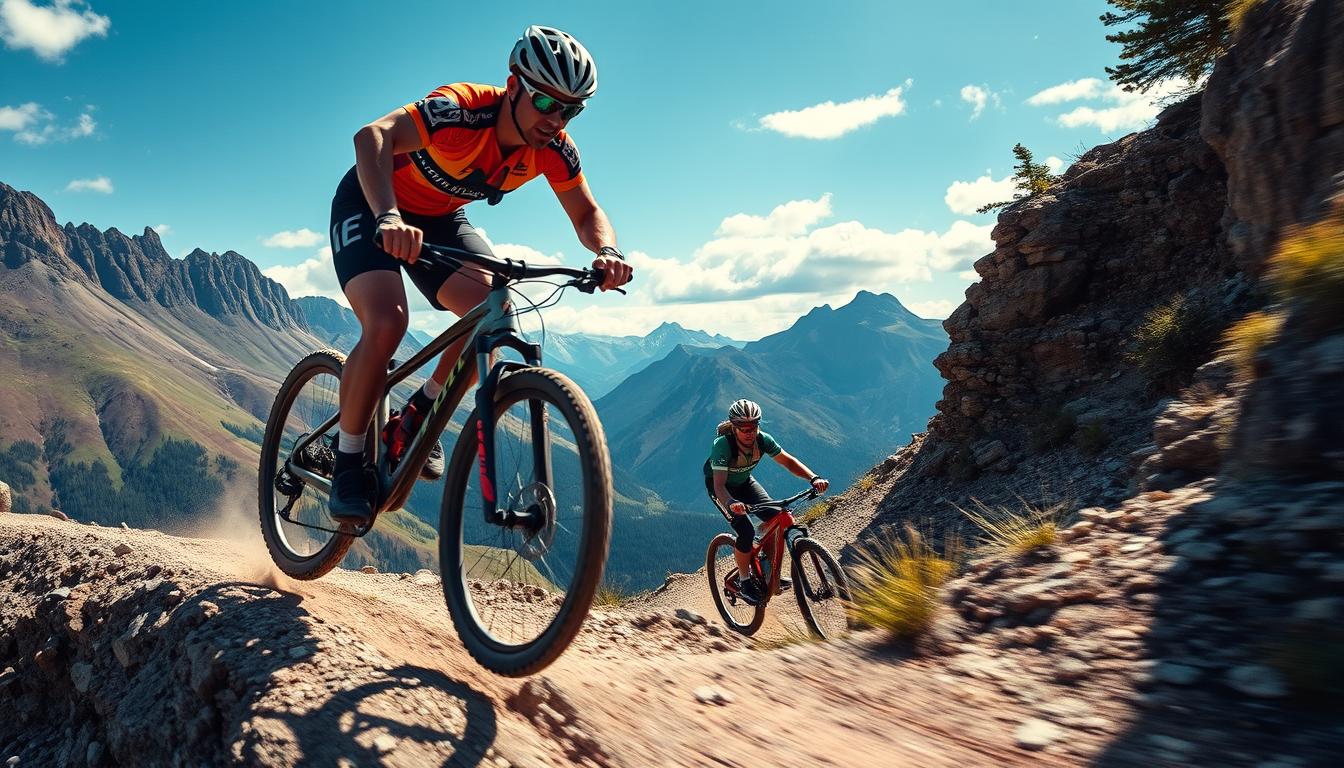Welcome to our detailed guide on mountain biking fitness. It’s crafted to boost your riding skills to the next level! You’ll learn how to mix strength training, endurance building, and technical skill development. This guide is perfect whether you’re starting or have years of cycling under your belt. Our tips are designed to help you face and overcome the challenges of different terrains.
Mountain biking is not just about pedalling. It works out many parts of your body and uses various energy systems. These include aerobic, anaerobic, and ATP-PC. That’s why it’s essential to have a fitness routine that meets these needs. James Wilson’s training programme is celebrated for its simple, effective approach. Many riders have seen great improvements. For real stories from bikers who tried this programme, check out the Ultimate MTB Workout Program community thread.
The Importance of Strength Training for Mountain Bikers
Strength training is vital for mountain bikers. It boosts trail performance and offers health benefits. Professionals like Nino Schurter and Kate Courtney share their routines online, showing its critical role.
Benefits Beyond the Trails
Strength training’s advantages do more than just improve your pedalling. It helps with:
- Enhanced bone density and joint health
- Better posture through correcting muscle imbalances
- Support in weight loss and management
- Keeping muscle mass as you get older
These benefits show why strength training is key for mountain bikers. For tips on improving bike skills with strength training, see this advanced enduro mountain biking guide.
Key Exercises for Mountain Biking
Adding certain exercises to your routine boosts cycling strength. Mathias Witt from Orbis Coaching suggests a targeted circuit. It focuses on crucial muscles.
- Walking Lunges with a twist – great for legs
- Ball Push-ups – build upper body power
- Deadlifts – target your hamstrings
- Renegade row or TRX rows – strengthen the upper back
- Side plank drops with reach – for core and shoulder stability
Try this circuit 3-4 times, twice a week for 4 weeks, to see improvements. Strength training regularly helps avoid injuries and control your bike better.
Building Endurance for Challenging Trails
For mountain bikers, understanding aerobic endurance is key. It lets riders keep up intense activity for a long time. This is particularly vital for ultra-endurance races. To cover large distances without losing speed, riders need to train hard.
Understanding Aerobic Endurance
Training for aerobic endurance is about improving how the body uses oxygen. A strong aerobic base lets riders keep a steady pace. It also helps with quick recovery on long rides. Cyclists use a mix of long rides and interval training to boost their speed and handle tiredness better.
Recommended Endurance Workouts
Diverse training sessions are crucial for building up endurance in mountain biking. Some effective strategies include:
- Long Rides: Increase the length of rides gradually to build stamina. Aim for a comfortable pace in Zones 1 and 2 to help recovery and enhance endurance.
- Tempo Training: Keeping your heart rate or power in Zone 3 for 30 to 90 minutes boosts your basic speed. Use intervals of 15 to 30 minutes with rest to practice pacing.
- Fasted Training: Rides before breakfast at low intensity help use fat better and improve endurance.
- Back-to-Back Long Rides: Planning two long rides in a row followed by a rest day helps with fatigue. It gets riders ready for races.
Mixing these workouts with strength and skills training gives a complete approach to endurance. Riding in different places, such as roads or trails, also helps improve overall fitness.
Mountain Biking Fitness Training Guide
Making a good training plan for mountain biking is all about thoughtful planning. You must design workouts that get tougher over time and meet each rider’s unique needs. A custom plan helps focus on specific improvement areas, like endurance, power, or technical skills.
Structuring Your Training Plan
A strong training plan is key for mountain biking success. It’s wise to favour longer, easier rides over short, hard ones for steady fitness growth. These gentler rides help you stay consistent since they’re easier on your mind and body. Adding different exercises, such as plyometrics, is great for boosting quick muscle response needed in races. This varied approach keeps fitness levels rising without hitting a plateau.
Adapting Workouts to Individual Needs
Each rider has their own set of strengths and areas to work on. Some might bike more, while others might hit the gym instead. Adjusting the schedule to fit 3-5 training times a week is advisable. Including easy rides on the road helps muscles get used to a mountain bike’s shape. By tailoring plans, riders can adjust their training based on how sore or tired they feel, getting them competition-ready.
Incorporating Technical Skill Development
For mountain bikers, learning technical skills is essential. It goes hand in hand with fitness. Mastering these skills lets riders handle complex trails with ease. Focusing on technique is key for a better riding experience on the trails.
Essential Skills for Trail Riding
Improving certain technical skills can boost your performance. Important skills include:
- Cornering – Mastering turns can improve your speed and control.
- Jumping – Getting good at jumps helps keep your ride smooth.
- Bike handling – Being agile on your bike helps you dodge obstacles easier.
Practising these techniques regularly makes riding on tough trails easier. Try to work on these skills during easier training days. This helps you get better without getting too tired.
Combination of Fitness and Skill Workouts
Blending fitness and skill exercises is smart. A balanced training plan might have:
- Short, intense interval training on a road bike.
- Mid-paced mountain bike rides to get better at cornering and handling.
- Longer, fun rides that build fitness while practising bike skills.
Mixing fitness with skill practice boosts your performance. Training on the bike you’ll race with is crucial. It helps you master the right skills for competition. This way, each trail ride is both fun and productive.
Conclusion
To succeed in mountain biking fitness, it is key to mix strength, endurance, and skill training. Every part is crucial to make training more effective. This ensures cyclists are ready for any trail challenge.
Having a variety of workouts, like intervals and long rides, is critical. Rest and recovery are just as important for the body to get stronger. We must not forget about eating well and staying hydrated, as they help with training and getting better.
By focusing on both fitness and skills in their training, cyclists are gearing up for victory. This method prepares them for races and boosts their love for mountain biking. It unlocks an exciting journey through the sport.
FAQ
What is the ultimate goal of the mountain biking fitness training guide?
The guide helps boost your mountain biking skills. It covers strength, endurance, and technical skills. It’s perfect for all rider levels.
Why is strength training important for mountain bikers?
Strength training boosts your trail performance and increases bone strength. It ensures healthy joints and corrects your posture. Plus, it helps in keeping a healthy weight and maintaining muscle as you get older.
How can I develop my aerobic endurance for mountain biking?
Building a strong aerobic base is vital. It lets you maintain high energy levels for longer. By doing endurance workouts made for biking, you can stay energetic on tough trails.
What should be included in a structured training plan for mountain biking?
Your plan should improve cycling-related fitness. Include strength, endurance, and skill training. Remember to rest and recover too.
What technical skills are essential for mountain bikers?
Key skills are cornering, jumping, and handling your bike. These skills enhance your riding and make it safer and more fun on various terrains.
How can I personalise my mountain biking training plan?
To personalise your plan, first check your fitness level. Set your own goals. Then, tailor workouts to your needs, focusing on strength, endurance, and skills for a balanced improvement.


